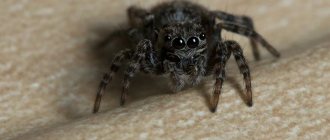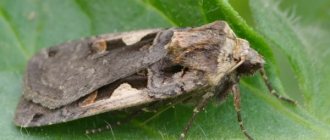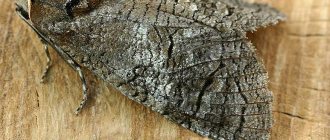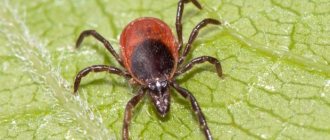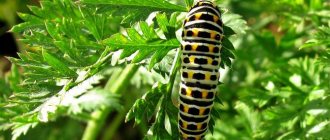Description of appearance
In our area there are several types of shashel - furniture, house. Each of these pests causes significant damage to wooden structures, furniture, even books and leather goods. Many people know what a shashel looks like, but they don’t realize that this is it:
- elongated body with a durable shell;
- color brown or black;
- the size of pests is several millimeters;
- on the head there is a long curled mustache with stripes;
- three pairs of long, fairly powerful limbs.
The woodworm itself is harmless and does not pose a threat to human life or well-being. But living with him under the same roof threatens serious damage to property.
Important!
The shawl larva is a thick caterpillar of a dirty yellow color with a well-developed mouthparts. It does not leave its burrows, so it is difficult to see it. But characteristic sounds give away their presence.
A photo of the shashel is presented below; you can clearly see all the features of the body structure and color scheme.
Shashel
We fight pest beetles
How to deal with insects that have begun to eat or may eat your house? You need to carefully check the wood for signs of beetles, treat it with special chemicals, or simply remove the corroded beams and beams and replace them with new ones.
Important! Unfortunately, even treated wood does not provide a 100% guarantee that bark beetles or shashel will not begin their life activity in it. The fact is that during the application of chemical compounds, liquid seeps only into the upper layers of the timber. If the insects are located deeply, they will continue to exist.
Preventive action
These are various options for processing materials before they enter the building structure. Thanks to special chemical compounds applied to the surface of lumber, the wood becomes unsuitable for beetles and protected from the formation of fungus.
Antiseptic treatment
A cheap but ineffective method of protection. When sprayed or applied with a brush, the antiseptic penetrates only 1-2 mm into the wood. Any chemical has a shelf life, usually from 1 to 5 years. After its expiration, the protective components are neutralized, and the tree becomes a tasty morsel for insects.
Heat treatment
The wood is heated in special chambers where there is no oxygen. The heating temperature reaches 140 degrees Celsius. Under its influence, nutrients such as sugar and starch break down. Consequently, the wood is not valuable for the bark beetle and shashel.
Interesting! Heat treatment will not only protect the wood from the formation of fungus and insects, but will also improve its performance characteristics. During firing, additional moisture evaporates, so the board becomes hard. A slight charring is formed on its surface, which increases the aesthetic appeal of the object.
Heat treatment is not a cheap pleasure. You can safely add 40-50% to the cost of the tree.
Autoclave
As a rule, valuable products (glulam beams and timber) are processed in an autoclave. The wood is placed in a certain container with antiseptic impregnation. Then a pressure of 100 atm is applied, after which the beetle cannot use wood fibers as food. You must understand that effective autoclave impregnation increases the cost of products by 50-70%.
Operational measures
How to fight a beetle if it has already infested the wood? You have 2 solutions: replace the tree with a new one or try to stop the reproduction of insects. The second option gives only a 50% guarantee that the larvae will be eliminated. Which method to choose is entirely up to you!
Injection
If the inlet holes are visible, you can try injecting a solution of sodium fluoride or sodium fluoride, which you can buy at any flower shop or fertilizer store. The process, although labor-intensive, is highly effective.
Procedure steps:
- Preparation of the solution: 250 ml of concentrate is diluted in 3 liters of water.
- Detection of inlet openings, cleaning them and purging them with a syringe.
- Preparation of gruel (a mixture of bread and concentrate).
- Introducing the solution using a syringe.
- Cover the entrance with a slurry of bread and concentrate.
Spraying makes it possible to rinse the passage from wood flour. The vapors from the solution will force the insect to look for a way out. The larva will move along the route along which it penetrated inside the product. To get out, she will have to chew through the cork of the poisoned bread. In this case, the insect will die, and you will get clean wood.
Tapping
Tapping helps kill shashel/bark beetles that have infested themselves in wooden floors or walls. The fact is that the body of the larvae consists of 85% moisture. The vibration from the impact is transmitted to the water, which is located inside the soft shell. After this, the insect's body ruptures, leaving only mucus. In places where the larvae die, new insects no longer appear.
Advice! In order not to leave traces of the blow of a mallet or hammer on the surface of the boards, use a block. It is the intermediate link between the tool and the wood.
Microwave treatment
It is known that inside the larva there is moisture with a high protein content. Protein coagulates when heated to 56 degrees. Thus, if the entire wooden structure is heated to 60 degrees, all the larvae will die, since their protein will coagulate. Unfortunately, it is not possible to heat wood with fire at home. But you can take a regular microwave oven and build a unit out of it to eliminate pests. How to do it? Very simple!
Stages of work:
- Remove the microwave wall, which is located opposite the magnetron (as a rule, it is located on the wall with the control panel).
- Determine by ear the location of the larvae.
- Place the open part of the device so that it is directed towards the location of the insects. Maintain the distance between the socket and the wooden surface. It should fall within the range of 2-3 cm.
- Connect the device in the next room to the network. they go to another room in order to protect their eyes from exposure to microwave radiation.
- Set the timer for 20 minutes. After it fires, direct the stove bell to a new section of wood.
If you want all wood pests to die, treat the entire structure in this way. Exposure to microwaves also has a detrimental effect on the development of mildew and mildew.
Another way to eliminate beetles from a wooden structure is to simply wait. Isn't it annoying to hear the noise coming from the tree while insects are eating? Then just wait 2-3 years. The larvae will mature, turn into mature individuals and leave the tree themselves. The main thing is to find the holes and cover them with sealant to prevent the penetration of new insects.
Another enemy of wood is mold. It is formed in the absence of ventilation and inadequate vapor barrier. It not only destroys the tree, but also promotes the appearance of pest beetles that will quickly wear it down (for example, borer beetles). To avoid the formation of mold, treat the wood with special solutions and make a ventilated façade made of wood.
Features of life
The presence of shashel in a tree is indicated by a specific sound, similar to the ticking of a clock or chirping. It reproduces during the mating period of beetles. You should look for them on the surface of the wood. Because woodworms leave their burrows during mating.
The location of the nest, as well as the degree of infection, is determined by the sound. The more intense and louder the ticking, the more pests there are in the house. Another characteristic sound is created by the larvae, which gnaw wood day and night with a special appetite. The burrows are filled with excrement, which crumbles over time, resembling sawdust or wood dust.
Adult beetles spend most of their lives in the nest, making more and more new passages in different directions. But the main pests are the larvae, which do not leave their burrows at all.
On a note!
Infection of a house occurs during construction, when using material with larvae, cabbage eggs, in old wooden houses with cracks in the wall, window sills, and doorways. And also in a new design, if no attention was paid to careful processing of the wooden components.
Peculiarities of shashel life
Appearance
The furniture grinder is not much different from other representatives of its species Anobium punctatum. This beetle is not picky about living conditions and sometimes announces its presence with loud clicking sounds at night, reminiscent of a ticking clock and causing real panic in some people. It’s not for nothing that people call these sounds “the clock of death.”
The most attractive wood for shashel is wood whose moisture content does not exceed 14%.
An adult beetle is small in size and barely reaches 0.45-0.5 cm. By the way, its size depends on living conditions. With an abundance of suitable food, individuals become larger and more noticeable. The color of shawls is variable and can range from dark brown to reddish. The body of the beetle is covered with silvery hairs. The yellowish or whitish larvae of the parasite are massive and stand out with pronounced segmentation.
Larval development
The shashel develops in the egg from 1 to 4 weeks. The first stage larva is a caterpillar. Starts sabotage immediately after birth. Gnawing through numerous passages. She molts periodically and gradually increases in size. The last stage larva reaches 4 mm.
It is difficult to say how long the shawl beetle lives in the larval phase. According to various sources. develops in the conquered territory from 3 to 15 years. At the last stage, it goes deep into the tree and pupates. It emerges to the surface as a wood-boring beetle that has already formed. But after mating, it returns to the tree again to build a nest and lay eggs.
Life processes of shashel
You can determine the presence of shawl beetles in the house by some sounds coming from the wooden elements of the house. The sounds are heard during the breeding season of beetles and resemble the ticking of a clock. Using this feature, you can determine the location of their nest, and the intensity of the sounds will help determine the scale of infestation. Adult beetles spend almost all their time in the nest, gnawing new passages in various directions.
It is worth noting that in most cases, infection occurs during the construction stage. The materials used are not always processed, as a result the house can be attacked by parasites.
Fighting methods
Methods of fighting insects How to get rid of shawl, there are several methods. The choice depends on the degree of infestation, financial capabilities, and personal preferences.
- Treatment with insecticides. Antiseptics and broad-spectrum drugs are used.
- The use of folk remedies. A special mixture is prepared that blocks the access of oxygen to larvae and adults, causing death.
- Exposure to microwaves. Carried out by specialists using modern equipment. The generator produces microwaves that are directed at the infested wood. It warms up and kills shashel larvae and beetles. The disadvantage of this method is that it is labor intensive and expensive.
- Dry steam treatment. The action is similar to the previous method. Dry steam heats the wood and reduces humidity. In such conditions, the shawl larvae and the beetles themselves die.
- Fumigation - fogation, fumigation. Hydrogen phosphide is used, which is capable of penetrating deep layers of wood and destroying shashel larvae and adult beetles.
At home, a chemical method is used using insecticidal preparations and folk remedies.
Key Features
The beetle is native to Eurasia. The parasite spread very quickly almost throughout the world. The largest populations are found in Europe and Russia. Shashel is nocturnal, it is unpretentious to living conditions and tolerates cold weather well.
The insect spends almost all its time in its long woody tunnels, leaving them to reproduce. Adults have a short life span; their entire existence is limited to mating and laying eggs.
Varieties
In our country you can find two types of parasitic bugs:
- Brownie.
- Furniture.
But each of them poses a serious threat to the wooden structures of the house and home furniture. The appearance of adult beetles in the house indicates a large population and an already large colony. Which means that the voracious larvae have already managed to spoil a lot of wooden things.
Insects produce peculiar “ticking” sounds at the moment of mating, making rhythmic head strikes against the tree.
Insect development
Shashels reach their maximum activity in late spring and early summer. After mating, the female parasite finds a suitable tree and attaches an egg clutch to it, infecting the wood. After 12-15 days, larvae emerge from the eggs and immediately begin gnawing out the tunnels. The larval stage lasts 1-3 years, then the shashel turns into an adult.
Expert opinion
Mityuk Stefania Bogdanovna
Shashels do not pose a threat to people; the beetles can bite a person, but do not provoke the development of allergies.
The greatest danger from shashel is the tree, which is completely destroyed in a very short period of time. In the fight against shawls, the difficult thing is their small size and nocturnal lifestyle. Spotting beetles is not easy, especially in the early stages. You can understand that a house is infested with gnats only by the loud sounds that the insects make on their noses and the appearance of numerous holes in the wood, from which gray-yellow dust spills out (these are the excrement of the larvae).
Proven Recipes
If a shashel has started in a wooden board, getting it out of there is problematic. But you can make sure that he either crawls out on his own or ends his life in a hole. Initially, you can use folk remedies.
- Boil 10 liters of water, mix hot with 250 g of potassium fluoride. Stir for 5 minutes, pour into a spray bottle. They process the wood from shashel. Work should be carried out with rubber gloves.
- To 10 liters of lime turpentine add 500 g of wax, paraffin, 300 g of creolin. Stir until smooth and process the wood.
- 3 liters of turpentine are mixed with 1 liter of gasoline. Using a brush, the wood is removed from the shashel.
A significant drawback for all traditional methods is the unpleasant, pungent odor. It is better to fight shawl in this way in a non-residential building or from the outside. Wood soaked in kerosene and gasoline becomes a fire hazard. Therefore, before using the product, you need to weigh the pros and cons.
Effective ways to fight
It is difficult to destroy a large population of multiplied beetles on your own. Radical measures should be applied in the early stages, when there are not so many grinders. The first step is to identify the area where the beetles live.
Carefully inspect:
- all furniture made using wood;
- floor coverings;
- wooden parts of the foundation, partitions and beams.
Upholstered furniture is no exception. After all, there are wooden frames and other wood parts. If necessary, it is even better to disassemble the furniture so as not to miss the parasite’s habitat.
Insecticides and antiseptics
The destruction of furniture grinders can be carried out using insecticidal preparations, as well as antiseptics.
Antishashel
Wooden surfaces are treated until completely absorbed; the drug shows best effectiveness when it is injected into the tunnels made by beetles (this can be done using a syringe). It is not addictive to beetles, does not spoil paintwork and floor coverings (it is used for expensive antiques, natural parquet), and has excellent penetrating ability.
Drevotex
Wooden surfaces are treated in several passes at intervals of 3-4 months, the drug is injected into the larval tunnels through a syringe (then the passages are covered with Vaseline or filled with paraffin). After treatment, it is effective for another six months, this drug is considered one of the most effective and safe for humans and animals, it is best used from July to the winter months
Empire 20
The insecticide is diluted in water in the proportion of 30 ml of the substance per 1 liter of water, and all wooden surfaces are treated with the solution. It is characterized by low toxicity and shows good results both in the fight against shawls and other woodworms.
Lignofix
Antiseptic impregnation for wood; the surface of the product is treated in several passes until completely saturated. They will not emit toxic fumes, are safe for people and pets, and after treatment the effect lasts up to 10 years.
Antibug
The product is applied over wooden products with a roller or brush, 2-3 times until completely saturated. The drug can also be used as a preventive measure; it is non-toxic and does not spoil the decorative properties of furniture.
When working even with low-toxic antiseptic impregnations, do not forget about personal protective equipment! And do not skimp on the preparation; it is necessary that the wood is completely saturated with it. Therefore, it is better to apply the product 3-4 times with an interval of 2-3 days.
Traditional methods
Such options of struggle are, of course, cheaper and do not require large financial expenditures. But this is where the advantages of folk remedies for fighting shawls end.
If you decide to use these methods, remember that they:
- They pose a greater danger to people and animals compared to chemical, specially developed preparations.
- They can spoil the appearance of furniture.
- More difficult to use.
- Ineffective, especially with a large population of shashel.
The most effective of all existing folk methods of combating grinder beetles are the following:
- Turpentine mixture . Turpentine in an amount of 10 liters is mixed with wax and paraffin (500 g each). Creolin (300 g) is also added. The mass is heated over low heat until a homogeneous solution is obtained. The resulting product is applied to the affected wood, especially carefully treating the holes from the larvae and various crevices.
- Sodium fluoride . Sodium in an amount of 250 g is dissolved in boiling water (10 l). The resulting mass is used to treat wooden surfaces. To speed up processing, you can use a spray bottle.
- Turpentine-gasoline mixture . Gasoline is mixed with turpentine at the rate of 1x3. This product is the most dangerous, as it is highly flammable and has caustic, harmful fumes.
Expert opinion
Mityuk Stefania Bogdanovna
Keep in mind that traditional methods of struggle are ineffective, dangerous and do not have a long-term preventive effect.
Professional preparations
Professional preparations for the pest Treatment of wood from shashel is carried out with antiseptics and insecticides.
- Antibug. A universal product against all wood pests. Destroys adult shawls and larvae at different stages of development. Process thoroughly once. But to consolidate the effect, repeated treatment is recommended after 14 days. Used for prevention. The remedy for shashel in the house is not highly toxic, but it is necessary to work with rubber gloves.
- Antishashelin. Destroys all types of wood borers. The composition contains silicones that can penetrate into the deep layers of wood and destroy shashel and its larvae. Used for processing old wood, fresh wood, furniture, antiques, floors, any wooden structures. Preserves the integrity of the tree and does not spoil the appearance.
- Woodtex. According to customer reviews, one of the most effective drugs. Helps destroy shashel and protects against re-infection for six months. It is recommended to treat several times throughout the year, every 3 months. The product is poured into the shashel passages with a syringe. Seal the holes on top with Vaseline and paraffin. For prevention, the procedure should be carried out in the middle of summer and winter. If the wood is severely damaged, treat the surface with a brush and apply a thick layer of the preparation.
- Lignofix. The antiseptic does not contain toxins. After use, it does not lose its properties for 10 years. Destroys chitin-containing insects. It enters the body, disrupts biological processes, and leads to death.
In order not to think about how to quickly and effectively get rid of shashel, it is necessary to inspect wooden structures twice a year and carry out preventive treatment.
Biological features of shashel
The pest is often confused with midges, because it is very small and can fly.
The body of an adult is dark-colored, most often dark brown or black, and cylindrical in shape. Delving deeper into the anatomy, we note that it has antennae and six light-colored legs, as befits an insect. The shell is dense, with a visible cover of small hairs. The upper hard wing covers are decorated with several longitudinal grooves. The head, compared to the body, is small. The yellow body of the larva is segmented and looks like a thick worm. The brown head is equipped with large powerful jaws. The larval stage of the beetle lives exclusively in dug passages, so it can only be seen by sawing the tree.
Given such characteristics, it is simply impossible to notice the presence of shashel from its very appearance. Usually the signs become obvious after a year of the pest living in the house. Gnawing through the passages, the larva immediately fills them with excrement and waste wood. When this mass dries, it gradually falls out. Only then does it become clear that uninvited guests have appeared in the house.
But the problem is not only damage to your favorite furniture or beautiful things. The main danger lies in the peculiarities of the shashel life cycle. Having chosen a future home for children, the pest bites into a tree and lays about 80 eggs at a time. If the necessary conditions are present, such as elevated temperature, dryness and darkness, all eggs, due to the absence of natural enemies, turn into larvae within 12-15 days. The period of the larval stage is long, up to 7 years. During this time, one larva gnaws passages with a total length of up to 40 km. Along the way, she molts several times and soon finds a suitable place where she calmly turns into a pupa. Growing up, the beetle lays eggs and dies within one month. The larval stage is the longest, the rest last about two years.
It is also important that the shashel is not interested in the type of wood, its age, natural color or painting. Only favorable climatic conditions are important.
Shashel in the kitchen
Housewives often find small dark-colored bugs, similar to shashel, in flour and cereals. In the kitchen, the woodworm lives only in wooden structures and is not interested in food supplies. This is another type of pest that looks like a shashel.
The methods of fighting are extremely simple. Throw away the contents, thoroughly wash the containers in which supplies were stored, and carry out a general cleaning of the cabinets. Wash the furniture with a vinegar solution.
Shashel does not live in cereals. This is a completely different type of pest. Therefore, there is no point in using antiseptics and insecticides in this case.
The main reasons for the appearance of shashel in the house
Shashel may appear in the house due to:
- use of contaminated wood during construction or renovation;
- improper storage of lumber and firewood;
- purchasing beetle-infested furniture from unscrupulous manufacturers;
- excessive moisture in wood.
So that you don’t have to worry about how to get rid of shashel in a wooden house, try to inspect all the wooden parts and structures of your home more often, and if you find even minor damage, treat them with special means. In addition, make sure that there is no high humidity in the house, and during the construction stage, pay attention to the quality of building materials. It is important that when constructing a structure, only new and bark-free wood is used.
How to identify tree infestation
Lumber affected by insects has characteristic differences:
- visible remains of tunnels under the bark of the wane - bark beetle;
- abnormal lightness of the board, holes Ø 2-5 mm on the surface, while the board appears intact, there are no moves - termite or shashel;
- wood flour (dust), sometimes black-brown in color - all insects.
Wood affected by pests is “not treated”, because insects always strive to capture the largest space and are distributed throughout the entire element or structure, as long as their number is sufficient. If signs of a beetle are detected, you should refuse to purchase the material. If the beetle is found in existing stocks, the material should be rejected and the infested products should be burned.
The presence of larvae in an existing structure can be determined by ear - they make a characteristic grinding or tapping sound as they bite into the wood. In the old days, this sound was called the “death clock”, because practically nothing was known about the possibility of fighting.
